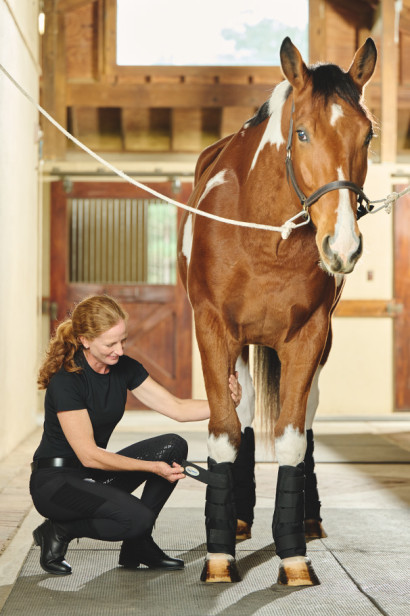The Power of Equine Therapy for Anxiousness, PTSD, and Emotional Healing
The Power of Equine Therapy for Anxiousness, PTSD, and Emotional Healing
Blog Article
Reviewing the Performance of Laser Therapy in Horse Therapy for Injury Rehabilitation
The evaluation of laser treatment's effectiveness in equine injury rehabilitation depends upon multiple factors, consisting of healing time, discomfort mitigation, and cells regrowth. Professional research studies recommend remarkable improvements in conditions like tendonitis and osteoarthritis, credited to enhanced mobile feature and raised ATP manufacturing. Vets often observe remarkable results with laser treatment contrasted to conventional methods, placing it as a vital component in equine care. Nonetheless, the necessity for continuous tracking and personalized therapy plans can not be overstated. What particular scientific proof supports these cases, and how do veterinarians execute these protocols in method?
Understanding Laser Therapy
Laser therapy has become a crucial device in vet medication, especially in the therapy of equine problems. Known for its non-invasive nature and efficacy, laser treatment includes the application of particular wavelengths of light to stimulate cells repair service and lower inflammation. This restorative technique is significantly preferred for its capacity to speed up the healing process in horses suffering from a selection of bone and joint injuries and chronic problems.
The key system behind laser therapy is its ability to improve mobile functions. Additionally, laser therapy promotes vasodilation, enhancing blood flow and oxygen delivery to broken tissues, hence expediting recuperation.
In equine medication, laser therapy is particularly helpful for problems such as tendonitis, osteoarthritis, and wound healing. The strategy is admired for its pain-relieving residential properties, allowing horses to restore flexibility and feature extra swiftly. Veterinarians additionally value its very little negative effects compared to various other therapy methods, making it a trustworthy and risk-free option for equine care.

How Laser Treatment Works

Upon absorption, these photons cause a series of biochemical modifications, enhancing mitochondrial function and bring about raised adenosine triphosphate (ATP) production. This rise in ATP increases cellular metabolic process, advertising cells repair service and regeneration. In addition, laser therapy modulates inflammatory reactions by affecting cytokine degrees and lowering oxidative tension, thereby relieving discomfort and swelling.
An additional substantial facet of laser therapy is its function in boosting microcirculation. The treatment advertises vasodilation, boosting blood circulation and oxygen delivery to broken cells (Equine Therapy). This promotes the removal of cellular particles and sustains the proliferation of fibroblasts and collagen synthesis, crucial for injury recovery
Professional Proof
The efficacy of laser therapy in equine therapy has actually been additional hints corroborated through various professional researches, showcasing its therapeutic prospective throughout a variety of problems. Several controlled trials and empirical researches have documented substantial renovations in tissue repair work, pain reduction, and total rehabilitation timelines. A research study conducted by Turner et al. (2012) demonstrated that equines treated with low-level laser treatment (LLLT) for ligament injuries displayed increased recovery compared to those obtaining traditional therapies. The study highlighted a marked reduction in swelling and enhanced collagen development.
In a similar way, research by Johnson and colleagues (2015) focused on equine muscle injuries, revealing that laser therapy substantially sped up muscle mass fiber regeneration and lowered muscular tissue stiffness. These findings were corroborated by histological evaluations showing enhanced muscle cells organization. Moreover, professional evaluations have actually shown that laser treatment can reduce chronic conditions such as osteo arthritis. A research by Smith et al. (2018) reported that steeds with osteoarthritic joints experienced notable discomfort relief and boosted variety of movement following a program of laser treatment sessions.
Vet Insights

Veterinarians additionally appreciate the convenience of laser treatment. She aims out that laser therapy can be tailored to the particular demands of each horse, ensuring ideal outcomes.
Furthermore, vets value the capability to incorporate laser treatment with various other treatment techniques. This multimodal method can boost official website total treatment efficiency, providing an extensive option for equine rehab. Such endorsements from experienced specialists underscore the growing approval and application of laser treatment in equine medication.
Practical Factors To Consider
A crucial element of executing laser therapy in equine treatment entails recognizing the practical considerations that ensure its efficacy and security. Primarily, it is important to pick the ideal laser device, as different kinds differ in wavelength, power, and infiltration depth. Equine Therapy. Vets should be fluent in these specifications to customize therapy methods effectively to each injury type
Additionally, the frequency and duration of laser treatment sessions require mindful planning to make best use of healing advantages while lessening any kind of potential adverse her latest blog impacts. Regular tracking of the equine's feedback to treatment can assist needed modifications in the treatment program. Developing a safe and controlled atmosphere throughout treatments is additionally vital to avoid unexpected direct exposure to laser emissions, which might hurt both the equine and the handler.
Training and qualification of employees carrying out laser treatment are extremely important to guarantee proper technique and to support safety requirements. Furthermore, maintaining precise documents of each session, including laser settings and observed end results, is crucial for examining the overall efficiency of the treatment and for making data-driven choices.
Conclusion
Laser treatment has actually emerged as an effective modality in equine injury rehabilitation, using significant benefits in recuperation time, discomfort relief, and tissue healing. Scientific studies highlight significant renovations in conditions such as tendonitis and osteo arthritis, attributed to enhanced mobile function and boosted ATP manufacturing. Veterinarian observations corroborate these searchings for, highlighting exceptional results compared to traditional treatments. For ideal outcomes, continual tracking and customized treatment procedures stay necessary in leveraging the full capacity of laser treatment in equine treatment.
Report this page